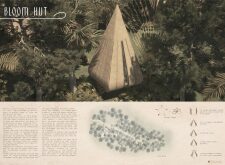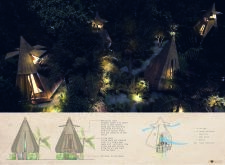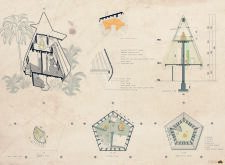5 key facts about this project
Unique Form and Sustainable Materiality
The defining characteristic of the Bloom Hut is its pentagonal shape, inspired by the symbolism of the Lotus flower, which represents purity and enlightenment. This geometric form not only provides structural integrity but also enhances the sensory experience of the space. The architectural design utilizes a range of sustainable materials, including wood, thatch, bamboo, and bolted steel frames. The extensive use of wood throughout the structure contributes warmth and an organic quality, while the thatched roof ensures effective insulation, representative of traditional building methods.
The incorporation of bamboo in the facade reflects a commitment to sustainability. Bamboo, known for its rapid growth and strength, aligns with contemporary eco-friendly practices. The bolted steel frame supports expansive open areas and large windows, allowing for natural light and ventilation. The wooden deck flooring connects the interior with the exterior, reinforcing the project's intention of blurring the lines between inside and outside.
Functional Design Elements
The Bloom Hut's design is highly functional, dividing the space into two primary modules: the lower living quarters and the upper meditation area. This duality facilitates an organized layout conducive to both daily life and introspection. The lower level features a combination of sleeping areas and communal spaces, enhanced by large windows that foster a connection to the landscape outside.
The upper meditation space is intentionally minimalistic, creating a calming atmosphere suitable for contemplative practices. The five wooden panels are strategically designed to open and close, allowing users to interact with the natural environment in a dynamic manner, promoting flexibility and comfort based on weather conditions.
Exploring Architectural Design Principles
One notable aspect of the Bloom Hut is its careful site planning, where pathways and landscaped areas encourage exploration while providing privacy. The integration of natural elements within the design invites occupants to engage with their surroundings meaningfully. The architecture prioritizes sustainability and passive design features, reducing reliance on artificial energy systems through natural ventilation and light.
In summary, the Bloom Hut exemplifies a thoughtful architectural approach that harmonizes functionality with sustainability. This project offers insight into contemporary design principles focused on health and well-being. Readers interested in architectural plans, architectural designs, and innovative architectural ideas are encouraged to explore the project presentation further to gain a comprehensive understanding of this unique architectural endeavor.


























